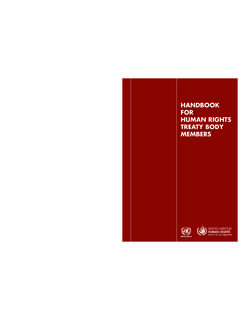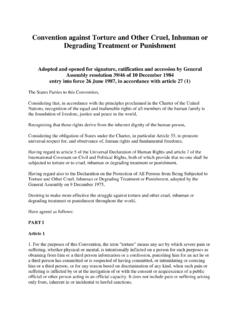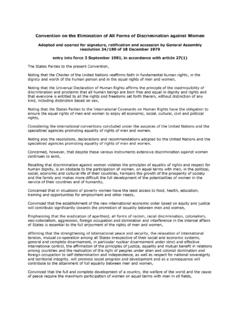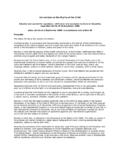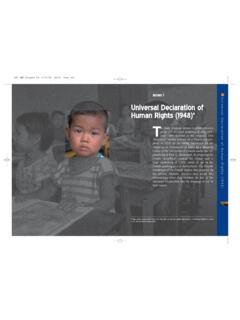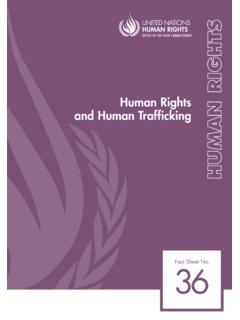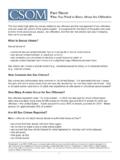Transcription of Fact Sheet No.23, Harmful Traditional Practices …
1 fact Sheet , Harmful Traditional Practices Affecting the health of Women andChildrenStates Parties shall take all appropriate modify the social and cultural patterns of conductof menand women, with a view to achieving the elimination of prejudices and customary and all otherpractices which arebased on the idea of the inferiority or the superiority ofeither ofthe sexes or on stereotyped roles for men ON THE ELIMINATION OF ALL FORMS OF DISCRIMINATION AGAINST WOMEN ( (a)),adopted by General Assembly resolution 34/180 of 18 December : Introduction I. An appraisal of Harmful Traditional Practices and their effects on women and the girl child II.
2 Review of action and activities by United Nations organs and agencies, Governments and NGOs ConclusionsAnnex:- Plan of Action for the Elimination of Harmful Traditional Practices Affecting the health of Womenand Children- Select BibliographyIntroductionThe Charter of the United Nations includes among its basic principles the achievement of internationalcooperation in promoting and encouraging respect for human rights and fundamental freedoms for allwithout distinction as to race, sex, language or religion (Art. 1, para. 3).In 1948, three years after the adoption of the Charter, the General Assembly adopted the UniversalDeclaration of Human Rights,(1) which has served as guiding principles on human rights and fundamentalfreedoms in the constitutions and laws of many of the Member States of the United Nations.
3 The UniversalDeclaration prohibits all forms of discrimination based on sex and ensures the right to life, liberty andsecurity of person; it recognizes equality before the law and equal protection against any discrimination inviolation of the international legal instruments on human rights further reinforce individual rights, and also protect-and prohibit discrimination against-specific groups, in particular women. The Convention on the Eliminationof All Forms of Discrimination against Women, for example, had been ratified by 136 States as of January1995. The Convention obliges States parties, in general, to "pursue by all appropriate means and withoutdelay a policy of eliminating discrimination against women" (art.)
4 2). It reaffirms the equality of human rightsfor women and men in society and in the family; it obliges States parties to take action against the socialcauses of women's inequality; and it calls for the elimination of laws, stereotypes, Practices and prejudicesthat impair women's cultural Practices reflect values and beliefs held by members of a community for periods oftenspanning generations. Every social grouping in the world has specific Traditional cultural Practices andbeliefs, some of which are beneficial to all members, while others are Harmful to a specific group, such aswomen. These Harmful Traditional Practices include female genital mutilation (FGM); forced feeding ofwomen; early marriage; the various taboos or Practices which prevent women from controlling their ownfertility; nutritional taboos and Traditional birth Practices ; son preference and its implications for the statusof the girl child; female infanticide; early pregnancy; and dowry price.
5 Despite their Harmful nature and theirviolation of international human rights laws, such Practices persist because they are not questioned and takeon an aura of morality in the eyes of those practising international community has become aware of the need to achieve equality between the sexes and ofthe fact that an equitable society cannot be attained if fundamental human rights of half of human society, women, continue to be denied and violated. However, the bleak reality is that the Harmful traditionalpractices focused on in this fact Sheet have been performed for male benefit. Female sexual control bymen, and the economic and political subordination of women, perpetuate the inferior status of women andinhibit structural and attitudinal changes necessary to eliminate gender early as the 1950s, United Nations specialized agencies and human rights bodies began considering thequestion of Harmful Traditional Practices affecting the health of women, in particular female genitalmutilation.
6 But these issues have not received consistent broader consideration, and action to bring aboutany substantial change has been slow or number of reasons are given for the persistence of Traditional Practices detrimental to the health andstatus of women, including the fact that, in the past, neither the Governments concerned nor theinternational community challenged the sinister implications of such Practices , which violate the rights tohealth, life, dignity and personal integrity. The international community remained wary about treating theseissues as a deserving subject for international and national scrutiny and action. Harmful Practices such asfemale genital mutilation were considered sensitive cultural issues falling within the spheres of women andthe family.
7 For a long time, Governments and the international community had not expressed sympathy andunderstanding for women who, due to ignorance or unawareness of their rights, endured pain, suffering andeven death inflicted on themselves and their female the apparent slowness of action to challenge and eliminate Harmful Traditional Practices , theactivities of human rights bodies in this field have, in recent years, resulted in noticeable Practices have become a recognized issue concerning the status and human rights of women andfemale children. The slogan "Women's Rights are Human Rights", adopted at the World Conference onHuman Rights in Vienna in 1993, as well as the Declaration on the Elimination of Violence against Women,adopted by the General Assembly the same year, captured the reality of the status accorded to issues have been further emphasized in the reports of the Special Rapporteur on Harmful traditionalpractices, Mrs.
8 Halima Embarek Warzazi, appointed in 1988, and in the draft Platform for Action for theFourth World Conference on Women, to be held in September Special Rapporteur on violence against women, its causes and consequences, Ms. RadhikaCoomaraswamy, appointed by the Commission on Human Rights in 1994, has also examined all forms oftraditional Practices referred to in this fact Sheet , as well as other Practices , including virginity tests, footbinding, female infanticide and dowry deaths, all of which violate female dignity. In her preliminary report,the Special Rapporteur pointed out thatblind adherence to these Practices and State inaction with regard to these customs and traditions havemade possible large-scale violence against women.
9 States are enacting new laws and regulations withregard to the development of a modern economy and modern technology and to developing Practices whichsuit a modern democracy, yet it seems that in the area of women's rights change is slow to be accepted.( , para. 67.)The Harmful Traditional Practices identified in this fact Sheet are categorized as separate issues; however,they are all consequences of the value placed on women and the girl child by society. They persist in anenvironment where women and the girl child have unequal access to education, wealth, health part I, the fact Sheet identifies and analyses the background to Harmful Traditional Practices , theircauses, and their consequences for the health of women and the girl child.
10 Part II reviews the action takenby United Nations organs and agencies, Governments and organizations (NGOs). The Conclusions highlightthe drawbacks in the implementation of the practical steps identified by the United Nations, NGOs andwomen's An appraisal of Harmful Traditional Practices and their effects on women andthe girl childA. Female genital mutilation(2)Female genital mutilation (FGM), or female circumcision as it is sometimes erroneously referred to, involvessurgical removal of parts or all of the most sensitive female genital organs. It is an age-old practice which isperpetuated in many communities around the world simply because it is customary.
